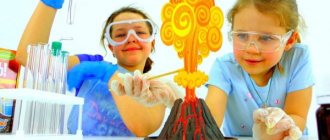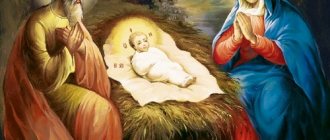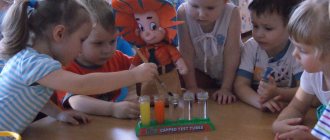Card index of games for cognitive and practical activities for children 4–5 years old
Anna Neustadt
Card index of games for cognitive and practical activities for children 4–5 years old
Experiments on the topic “Air”
1. "Properties of Air"
Purpose: to consolidate knowledge about air, introduce its properties , give the concept that air takes up space.
Material: strips of paper, paper parachutes, round and oval balloons.
Experiments.
1. Blow on a piece of paper, it will deviate to the side - air movement.
2. Launch the paper parachute, it will slowly descend.
3.Inflate the balloon: round and oval. The air took the shape of a ball and an oval.
4. Squeeze a round, slightly inflated ball - it will flatten, release - it will take its previous shape.
5. Find out the children’s understanding of the expression: “Getting away with it”
. Find out if it is possible to place a napkin at the bottom of the basin without getting it wet. Place a paper napkin on the bottom of the glass, turn the glass upside down and lower it into a bowl of water. After removing the glass from the water, give the children the opportunity to examine the napkin. What stopped the water from getting her wet?
Conclusion: air moves with different forces if it is released in a small stream; air takes the shape of the object in which it is placed; the air was in the glass, so it did not let water into it and the napkin remained dry.
2."Ball Rocket"
Purpose: to help determine that air has elasticity, to understand how the force of air can be used.
Material: balloons of different shapes.
Experience. Inflate the balloon without tying it and release it. Note that the air noisily escapes from the ball and pushes it in the opposite direction. Launch balls of different shapes and elasticity, mark the trajectory and flight range. Determine what determines the range and altitude of the ball. Explain that this principle is used in jet engines.
Conclusion: air has elasticity, can be compressed, occupy a smaller volume, and when leaving the ball pushes it, creating a force of movement.
3."Balls"
Purpose: to show that when individual objects are filled with air, they acquire elasticity; identify the use of this quality by a person.
Material: two balls.
Experience. Offer to take two balls of different colors and elasticity (strong and weak)
and knock them off the floor. See which ball is easier to hit and bounces higher off the floor. Find out which ball is easier and more interesting to play with.
Conclusion: a hard ball has more elasticity.
Experiments on the topic “Water”
1. “Find a quick way to warm up ice cubes and ice cream.”
Goal: to form the idea that ice and ice cream melt faster from warm air than when covered with a fur coat or blanket.
Material: pieces of ice, ice cream, blanket, fur coat.
Experience. Add ice and ice cream of the same size. Offer to compete to see who can melt one of the named objects most quickly. For work, suggest choosing a battery, a fur coat, or just a plate. After the ice and ice cream have melted, find out why they melted slowly under the fur coat or blanket. Are fur coats and blankets warm? What are the fur coat and blanket for?
Conclusion: ice cream will melt faster on the radiator - where there is more warm air.
2."More less"
Goal: to learn to determine the amount of liquid by eye and using a conventional measure in vessels of different shapes and sizes.
Material: cans, bottles of different shapes and sizes, but of the same capacity, measuring cup.
Experience. Pour the same amount of water into all containers. Which one has more (less)
liquids and why? Offer to measure the water with a measuring cup, noting the measurement result.
Conclusion: the liquid takes the shape of the container in which it is placed.
3.“How does a thermometer work?”
Purpose: to show how a thermometer works.
Materials: outdoor or indoor thermometer, ice cube, cup.
Experience. Squeeze the liquid ball onto the thermometer with your fingers. Pour water into a cup and put ice in it. Stir. Place the thermometer in the water with the part where the liquid ball is located. Again, see how the liquid column behaves on the thermometer.
Conclusion: when you hold the ball with your fingers, the column on the thermometer begins to rise, but when you lower the thermometer into cold water, the column begins to fall; heat from the fingers heats the liquid in the thermometer (as the liquid heats up, it expands and rises from the ball up the tube); cold water absorbs the heat of the thermometer (the cooling liquid decreases in volume and falls down the tube)
.
Experiments on the topic “Sand”
1.“Different water permeability of sand and clay”
Goal: expand children's about the properties of sand and clay.
Material: 2 cans, sand, clay, water.
Experience: Prepare 2 jars: one with sand, the other with clay. Pour equal amounts of water into jars with sand and clay. In a jar with sand, water seeped to the bottom, but in a jar with clay it remained at the top.
Conclusion: sand allows water to pass through well, but clay retains it and does not let it through.
2."Hourglass"
Goal: introduce children to hourglasses , teach them how to make them themselves.
Material: hourglass, 2 plastic bottles.
Experience. Show children a real hourglass and watch how the sand pours. Give the opportunity to feel the duration of a minute. You can make an hourglass yourself: connect two plastic bottles, pour sand into one of them, and turn it over. Sand will flow from one bottle to another in a certain time.
Conclusion: You can use sand to measure time.
Experiments on the topic “Man”
1."Eyes"
Purpose: to give an idea that the eyes are one of the main sense organs; give basic knowledge about the structure of the eye.
Material: camera, poster “Structure of the eye”
, mirror.
Experience. Bring in the camera, press the button - a small window opens: rays of light pass through it and hit the film, drawing on it what we want to photograph. The eyes are the same way.
- Look into each other's eyes. What do you see in the middle? (Black dot, with a colored circle around it.)
This colored circle is the iris. In people it comes in different colors: brown, green, blue. The black circle in the middle is the pupil. Through it, light enters the eye, and we see what we look at. Look into each other's eyes. What color are they? What eye color is your neighbor's, your mother's, yours? Look at your eyes in the mirror.
Conclusion: eyes are one of the main sense organs; with the help of our eyes we have the opportunity to see our surroundings; Everyone's eye color is different, but there are people with the same eye color.
2."Eyesight check"
Purpose: to show the dependence of the quality of vision on the distance to the object.
Material: subject pictures , blindfold, chalk.
Experience. Blindfold one of the children . What is visible? Why? Remove the bandage, bring the picture . What is shown in the picture ? (Hard to see.)
What do you need to do to see the image clearly?
(Move
the picture further from the eyes .) Children in pairs check each other’s vision, mark the distance from which the image in
the pictures . Move the picture far away .
Good visibility? Conclusion: it is difficult to see an object that is very close or very far from the eyes.
3."Guide"
Purpose: to show partial compensation of vision by other senses.
Material: eye patch.
Experiments.
1. Didactic game “Guide”
.
one of the children's eyes with a blindfold, the other child - the guide - leads him between the arranged objects, warning him of danger. Ask a blindfolded child: “Did you see anything through the blindfold? Would it be convenient for you to go alone?”
For everyone else:
“Have you seen blind people on the street and how can you recognize them?”
2. the children into two groups. The first group is blindfolded. Children of the second group silently choose a partner from the first group and approach him. Everyone is blind
examines his partner with his hands: face, clothes, hairstyle, calls his name. At the end of the game, discuss the orientation of blind people, name the reasons why vision may deteriorate: prolonged viewing of TV, playing on the computer, reading in the dark, low bends when writing and drawing.
Conclusion: Vision loss can be partially replaced by other senses; vision must be protected, daily routine and seating rules must be followed while writing and reading.
The use of visual material when organizing experimental activities in preschool educational institutions
Within the framework of the designated topic, we are not talking about visual materials traditionally used in classes - posters, illustrations, cards with diagrams. Research activities are accompanied by a mandatory stage of work - documenting the information received. The teacher should draw the children's attention to the fact that scientists (researchers and inventors) write down their observations and conclusions that they come to in the process of studying any phenomena or properties of objects.
To record observations of preschoolers, the following forms can be used:
- Research cards. The children fill out special forms, which are then compiled into a file cabinet of observations and experiments.
- Personal diary of observations. This form offers more room for creativity and expression of individuality than cards. Children can be allowed to make notes, sketches, and diagrams in their diary.
- Stands. You can record children's experimentation by designing stands: hanging a plan for conducting experiments, diagrams and photographs with the results.
- Lapbooks are hand-made folding books on the topic of research carried out (“Water”, “Weather”, “Insects”, “Properties of Air”, etc.). Templates can be used to create such books. It will be great if parents help the children in designing lapbooks.
Cognitive activity - what is it?
Cognitive activity is the process of assimilation and improvement of knowledge, its continuous increase and development.
This type of activity is inherent only to humans, and belongs to the highest form of mental cognition. It represents a symbiosis of sensory perception, theoretical awareness and practical actions. Accompanying all types of activities, it only at the moment of training acquires a clear, pronounced form and becomes conscious.
The basis of cognitive activity is the process of cognition, as the mental processing and mediation of information, ensuring the acquisition and accumulation of knowledge.
The process of cognition is one of the three processes that make up human consciousness, along with experience and reflection. It is realized through such mental processes as:
- attention;
- memory;
- thinking;
- speech;
- perception;
- sensation;
- performance;
- imagination.
To implement it, the following components are required:
- object (information, knowledge);
- subject (receiving knowledge - cognizing);
- cause-and-effect relationship between subject and object (why it is necessary to acquire this knowledge).
The result of such influence is the acquired knowledge as the fourth component of this process. Knowledge may be true or false, but it is still the result of knowledge.
Sensory and rational cognition
At the moment of assimilation of knowledge, each person uses a certain structure, the same for all people . It is based on the senses, as structural elements of cognitive abilities, identically involved, dictating the general laws of cognition.
The knowledge of each person includes 2 steps:
- sensory (empirical) – considering sensations, perceptions and ideas as the main form of genuine comprehension. This is the case when a person himself understands what is happening;
- rational - considering reason as the support, source and main measure of the reliability and infallibility of human aspirations. In this situation, a person not only understands, but is also able to explain and even prove what he understands to another.
Sensory cognition includes three multi-level forms, established from lower to higher:
- sensation;
- perception;
- performance.
Sensations are primary information about objects obtained with the help of analyzers; they are also the most primitive and do not reflect the integrity of the object:
- color;
- smell;
- taste;
- tactile sensations.
Perception is already a combination of several sensations and a more complex form of sensory acquisition. Fragmentary sensations merge into a holistically defined image. There is a separation of one object from another. Through perception, an adequate recognition of an object and the relationship of its images are achieved.
Representation is a transitional link between sensory and rational comprehension, containing sensory and rational elements of study. Its specific feature is the separation of the image from the object: the ability to represent the object in its absence. The ability to mentally operate an object without direct contact with it. In other words: use imagination and fantasy in relation to the object.
The prerequisites for rationality are:
- separation of thought from the subject;
- thinking as the completion of the generalization process, the formation of abstract concepts: matter, mass, time, space.
Rational cognition as a thinking process includes 3 forms of one-level order:
- concept;
- judgment;
- inference.
However, such a process is not feasible without such specific techniques of abstract logical thinking as:
- comparison;
- analysis;
- synthesis;
- induction;
- deduction;
- idealization;
- abstraction.
Thanks to them, conclusions are drawn. By comparing, analyzing and synthesizing the data obtained, a person forms his own conclusions. Comparison is the main method of mental activity.
Both stages are in organic unity, interconnection and interpenetration, passing into one another like a diffuse phenomenon. The system of human analyzers, as a stage of sensory development, is created for the perception of sensations, and rational thinking is created for forming conclusions based on the information received. This allows us to obtain the most objective conclusions while constantly pursuing the main goal of knowledge - the search for truth.
Practical activities
Among the various activities, practical activities are of great importance. It is a way of including a person in the world around him and actively influencing him in order to transform existing objects and create new ones. Through practical activity, a person understands his capabilities through experience, studies the world around him, and finds his place in it. As a result, his inner world changes, his spiritual life is filled.
Finished works on a similar topic
Course work The essence of practical, cognitive, evaluative activity 450 ₽ Abstract The essence of practical, cognitive, evaluative activity 240 ₽ Examination The essence of practical, cognitive, evaluative activity 210 ₽
Receive completed work or specialist advice on your educational project Find out the cost
Practice is realized in the course of subject-object and subject-subject relations; it is always of a social nature. It presupposes the existence of a certain culture of communication as a condition for its existence. In addition to the active transformation of the external environment, practical activity presupposes the communication of people in the course of their work, as well as a set of values, norms, and rules that ensure the purposeful nature of the activity.
The following forms of practical activity are distinguished:
- production practice - the production of material objects, this type of activity underlies all human life;
- technical activity - the transformation of certain devices created by man (artifacts), an element of the productive forces that determines the nature and method of social production;
- social practice - transformation of the social environment, social relations, can be revolutionary in nature;
- science is a special form of activity that turns into a direct productive force that also controls social processes.
Note 1
Thus, practical activity can be aimed not only at transforming material objects, but also at changing social relations and social practice.
The most important function of practical activity is the ability to test our knowledge and resolve the question of truth. Only through practice can truth be separated from error. However, practice opportunities are limited.



